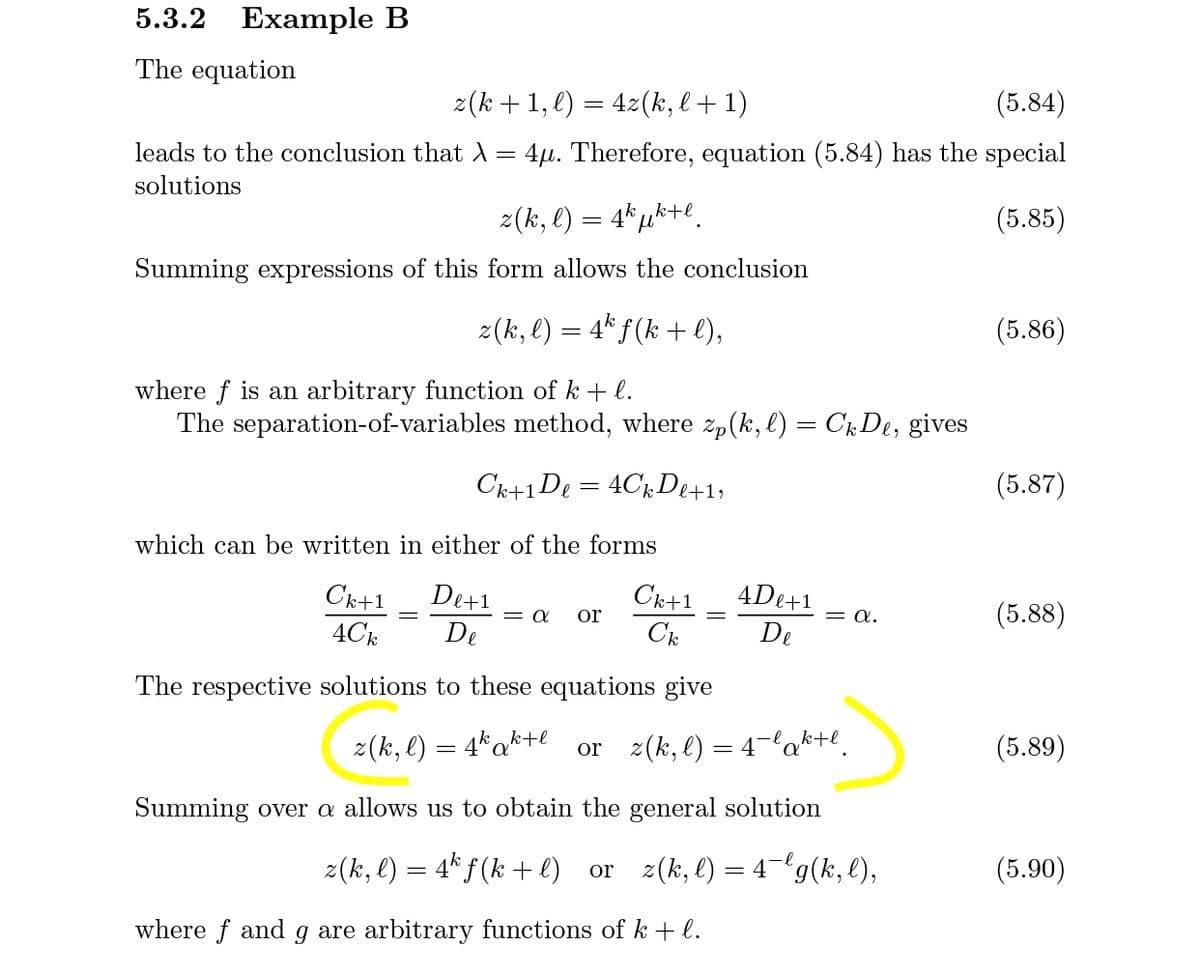Example B The equation z(k+1, l) = 42(k, l+ 1) (5.84) leads to the conclusion that A = 4µ. Therefore, equation (5.84) has the special solutions 2(k, l) = 4*µk+e. (5.85) Summing expressions of this form allows the conclusion z(k, l) = 4* f(k + l), (5.86) where f is an arbitrary function of k + l. The separation-of-variables method, where zp(k, l) = CkDe, gives Ck+1De = 4CkDe+1; (5.87) which can be written in either of the forms Ck+1 De+1 Ck+1 or 4De+1 = a. (5.88) 4С = a De Ck De The respective solutions to these equations give z(k, l) = 4*ak+l or z(k, l) = 4-ak+e. (5.89) Summing over a allows us to obtain the general solution z(k, l) = 4* f (k + l) or z(k,l) = 4 g(k, l), (5.90) where f and g are arbitrary functions of k + l.
Example B The equation z(k+1, l) = 42(k, l+ 1) (5.84) leads to the conclusion that A = 4µ. Therefore, equation (5.84) has the special solutions 2(k, l) = 4*µk+e. (5.85) Summing expressions of this form allows the conclusion z(k, l) = 4* f(k + l), (5.86) where f is an arbitrary function of k + l. The separation-of-variables method, where zp(k, l) = CkDe, gives Ck+1De = 4CkDe+1; (5.87) which can be written in either of the forms Ck+1 De+1 Ck+1 or 4De+1 = a. (5.88) 4С = a De Ck De The respective solutions to these equations give z(k, l) = 4*ak+l or z(k, l) = 4-ak+e. (5.89) Summing over a allows us to obtain the general solution z(k, l) = 4* f (k + l) or z(k,l) = 4 g(k, l), (5.90) where f and g are arbitrary functions of k + l.
Algebra & Trigonometry with Analytic Geometry
13th Edition
ISBN:9781133382119
Author:Swokowski
Publisher:Swokowski
Chapter6: The Trigonometric Functions
Section6.4: Values Of The Trigonometric Functions
Problem 22E
Related questions
Topic Video
Question
Explain the determine yellow

Transcribed Image Text:5.3.2 Example B
The equation
z(k + 1, l) = 4z(k, l + 1)
(5.84)
leads to the conclusion that A = 4µ. Therefore, equation (5.84) has the special
solutions
2(k, l)
4k
(5.85)
Summing expressions of this form allows the conclusion
z(k, l) = 4* f(k + l),
(5.86)
where f is an arbitrary function of k + l.
The separation-of-variables method, where zp(k, l) = CkDe, gives
Ck+1De = 4CkDe+1;
(5.87)
which can be written in either of the forms
Ck+1
De+1
Ck+1
4De+1
= a.
(5.88)
or
4С
De
C
De
The respective solutions to these equations give
2(k, l) = 4*a*+e or z(k, l) = 4-la*+l.
(5.89)
Summing over a allows us to obtain the general solution
z(k, l) = 4* f (k + e)
or z(k, l) = 4¬'g(k, l),
(5.90)
where f and g are arbitrary functions of k + l.
Expert Solution
This question has been solved!
Explore an expertly crafted, step-by-step solution for a thorough understanding of key concepts.
Step by step
Solved in 3 steps

Knowledge Booster
Learn more about
Need a deep-dive on the concept behind this application? Look no further. Learn more about this topic, advanced-math and related others by exploring similar questions and additional content below.Recommended textbooks for you

Algebra & Trigonometry with Analytic Geometry
Algebra
ISBN:
9781133382119
Author:
Swokowski
Publisher:
Cengage

Algebra & Trigonometry with Analytic Geometry
Algebra
ISBN:
9781133382119
Author:
Swokowski
Publisher:
Cengage